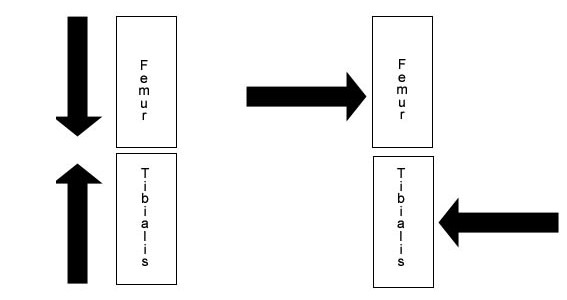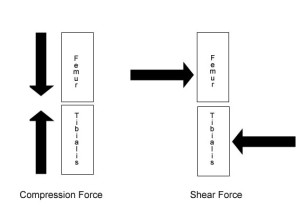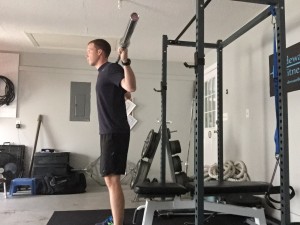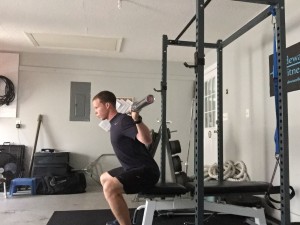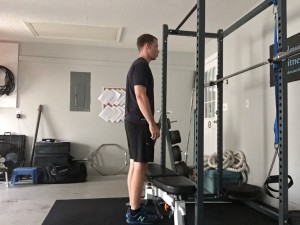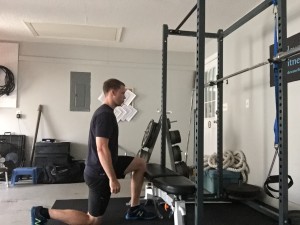One of the most frustrating things you will (or may have) encounter(ed) while training is knee pain. Unfortunately, it’s a common occurrence for many people.
Anytime you are dealing with joint pain, you have to be careful. By careful, I don’t mean stop training all together. I simply mean being creative with the way you train.
When someone sees a doctor about joint pain, more times than not, they will tell them it’s caused by arthritis or something similar. Then they provide them with a steroid shot. I hate seeing this happen, because all it does is mask the pain.
If you receive a shot, the relief is temporary. Within a few months, the pain will return and you’re back to square one. That’s why it’s so important to figure out why the pain is there in the first place.
When it comes to the knee, one of the main pain-causing culprits during exercise is shear stress. I’ve talked about this in some of my previous articles. In this case, it refers to the knee traveling forward excessively.
One of the big myths in the fitness world is that the knee shouldn’t go over your toes. This isn’t true. Think about it, your knee travels over your toes as you walk down stairs but few people experience pain here.
Allowing the knee to travel over your toes during an exercise isn’t the problem. The problem is when the knee moves so far forward that it creates shear stress you can’t handle. And this is typical of the average person with they squat or lunge.
These two exercises are more quad-dominant, meaning they target the quadriceps more so than the glutes and hamstrings. Because of this, the tendency is to place more weight on the front of the foot, which pushes the knees forward and creates a lot of pressure. The knee joint isn’t designed to handle a large amount of stress, explaining why pain can be common.
This is why I want to show you 2 quick fixes you can use anytime you experience knee pain during squats and lunges. Check them out below!
1. Switch to a box squat
Box squats are great because they allow you to sit back more during a squat and place the load on the hips. The hips are much larger than the knees, and fully capable of handling more stress thus making them knee friendly.
Here’s how it’s done:
a. You can use a bench if you don’t have access to a box at your gym. All you need to do is set the box or bench behind you.
b. As you begin to squat think about pushing your hips back and knees out.
c. Continue lowering your hips until you barely tap the box. Do not sit on the box.
d. Once you have made contact, push through your heels and return to the starting position.
That’s all there is to it. The big key here is to focus on pushing your hips back more. In this example, I am performing a back squat. You can use this for any squat version though (front, goblet, zercher, etc).
2. Use a bench to block forward knee movement during lunges
There are several types of lunges. Forward lunges aren’t tolerated by people experiencing knee pain as well as reverse lunges. The reason being the knees have to help decelerate your forward movement, which further increases knee stress.
That’s why the reverse lunge is a better option here. Having said that, there are still those who experience pain when doing them. That’s where using a bench to block excessive forward knee movement can come in handy.
Here’s how it’s done:
a. Set up on the side of a bench, roughly a few inches away.
b. Step back and plant the ball of your foot firmly on the ground while simultaneously lowering your knee to the floor. The knees should maintain around a 90° angle at the bottom position.
c. Barely tap your knee on the floor, push through the heel on the front foot and the ball of the back foot and return to the starting position.
In this exercise, the bench allows the knee to stay more vertical. This will decrease the amount of shear stress placed on the joint and keep pain at bay.
*****
Knee pain is never fun to go through and can limit your ability to perform lower body exercises. But more often than not, changing the way you perform an exercise can be the difference between pain and pain free.
Squats and lunges are great for burning fat, which means they should be staples in your workouts. Use these fixes if you experience knee pain during squats and lunges so you can get back to training hard!
Photo Credit:
1. http://www.precisionnutrition.com/research-review-front-or-back-squats

